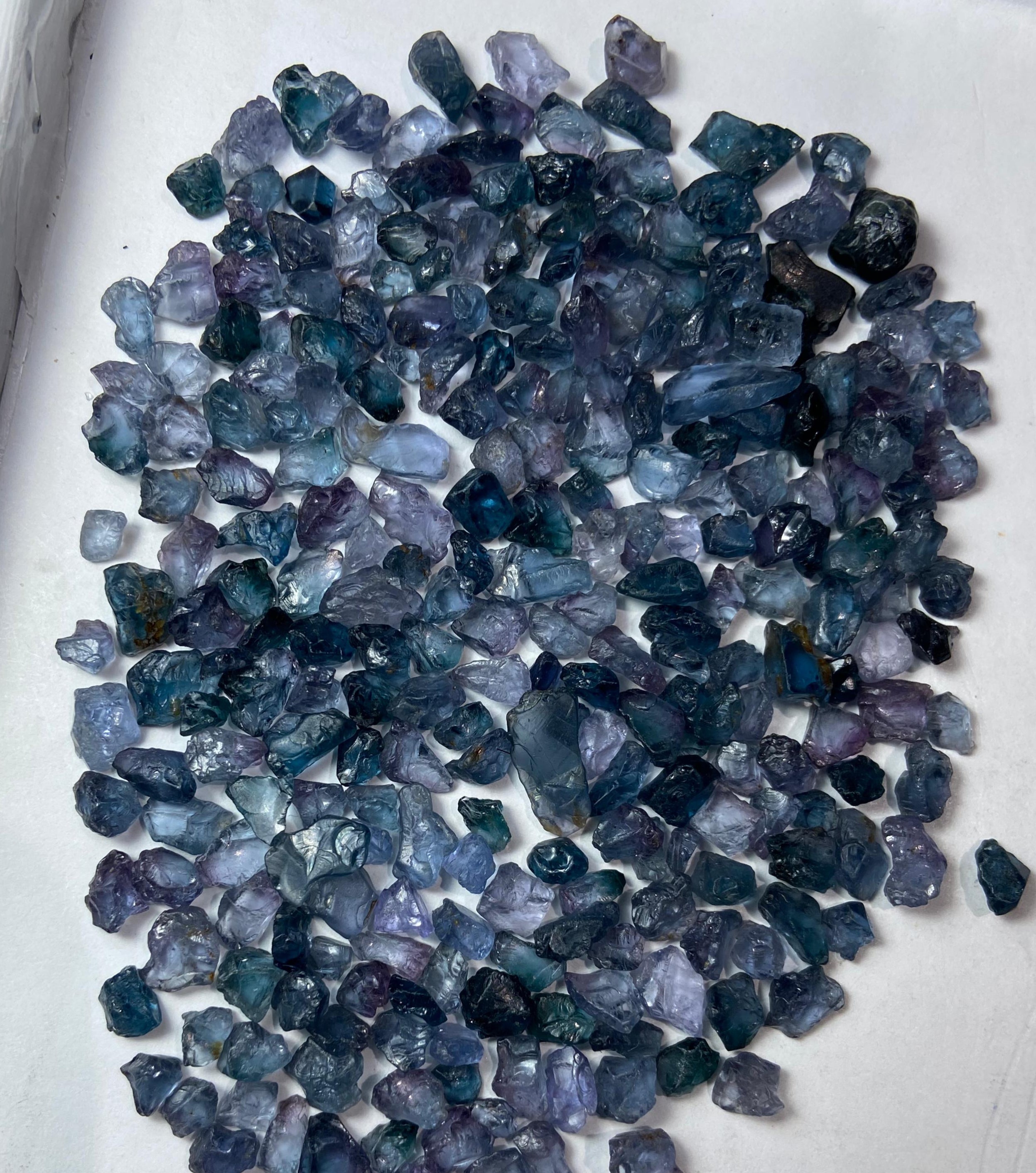
Pay With
Your transaction is protected with advanced security measures to keep your information confidential
Gemstone Specification
| Specification | Details |
|---|---|
Stone Name | Spinels |
Gems Type | Precious Stones |
Carat Weight | under carat to 1 carats |
Shapes / Cut | Rough Loose Shapes |
Color of Gems | Purple, Lavender, and Indicolite |
Clarity | Eye Clean, Transparent, VS, and VVS |
Origin | Myanmar |
Treatments | No |
Birthstones | August |
Category Types | Facet Rough |
Deal Type | Small Bulk Lots / Start Up Deals |
| Specification | Details |
|---|---|
Stone Name | Spinels |
Gems Type | Precious Stones |
Carat Weight | under carat to 1 carats |
Shapes / Cut | Rough Loose Shapes |
Color of Gems | Purple, Lavender, and Indicolite |
Clarity | Eye Clean, Transparent, VS, and VVS |
| Specification | Details |
|---|---|
Origin | Myanmar |
Treatments | No |
Birthstones | August |
Category Types | Facet Rough |
Deal Type | Small Bulk Lots / Start Up Deals |
Product Description
Grabs Deals on Natural Facet-Grade Rough Spinels for Lapidary Artists
Gemstone cutters can now access this stunning Burmese spinel parcel, ideal for faceting or cabbing. Available in 50, 100, or 150 carat lots.
Key Features:
- Stone Name: Natural Raw Spinel Stones
- Total Weight of Deals: 50 carats - 100 carats deals
- Size Range: .40 carat up to 2.50 ct per piece
- Color Range: Predominantly purple to violet with blue-purple secondary tones; includes deep royal purple, lavender-purple, violet-blue, and teal-blue specimens.
- Transparency: Transparent to semi-transparen
- Treatment: None – 100% natural & untreated
- Origin: Burmese
- Hardness: 7.5 – 8.0 on Mohs scale (ideal for durable faceted stones)
- Ideal for: Faceting, Making faceted loose stones, Cabochons
Additional Characteristics
- Irregular rough forms
- Color saturation ranges from medium to strong intensity
- Several pieces display clean, gem-quality windows
- Natural inclusions visible include silk and minor surface pitting which are found and consistent with untreated material
Technical Analysis of Facet Grade Raw Purple Spinels
Specifications of Spinel Rough lot
- Hardness: 7.5-8.0 Mohs (excellent durability for faceting)
- Crystal System: Cubic (isometric) - no cleavage planesSpecies: Natural Spinel (MgAl₂O₄)
- Origin: Burma (Myanmar)
- Treatment: Natural / Unaltered
Quality Assessment of Rough Lot
Transparency and Clarity Levels
- Lot has mixed transparency i.e. from transparent to semi-transparent
- The lot is suitable for approximately 30 to 40% yield for precision faceting
- The spinels may have some common inclusions such as silk, fingerprint inclusions, minor surface pitting
Yield Analysis and Cutting Potential
Size Distribution of the Spinel Lot:
- Stone weights range: 0.40-2.50 carats per piece
- Size ranges for calibrated cuts and matched pairs in small sizes or Melee sizes
- The rough lot of spinels is perfect for both commercial and custom cutting projects
Recommendations over Cutting Approaches:
- Precision Faceting: One can cut them and shapes into round brilliants and ovals.
- Fancy Cuts: Freeform designs to maximize unique color patterns
- Cabochons: Dome shape cabochons
- Calibrated Stones: Standard melee sizes for jewelry setting such as 1mm, 2mm, 3mm, 4mm, 5mm
Technical Cutting Tips and Facts Under Consideration
- Use fiber optic lighting to identify color concentration zones
-
Shallow crown angles (35-40°) recommended for maximum brillianceOrient table perpendicular to color bands for even distribution
- Consider pavilion depth of 43-45% for optimal light return
Polishing Characteristics:
- Final polishing: 100k diamond or cerium oxide on felt
- Brilliant polish can be got with standard diamond compounds
- Recommended sequence: 3000 → 8000 → 14000 → 50000 diamond grit
- Adjust lap speed as medium to prevent thermal shock
Dopping & Handling of Spinels:
- Adjust with Low thermal expansion - Ensure stable during heating/cooling cycles
- Use standard dopping wax
- Ensure minimal risk of thermal fracturing
Market Value of Spinel Gemstones Indicators
- Beginner-Friendly: This parcel is excellent training material due to forgiving nature
- Commercial Viability: Spinels have strong market demands
- Yield Optimization: 35-50% typical yield for experienced cutters
- Matched Pairs: The lot has a potential for creating valuable matching sets
FAQs - Spinel Rough Guidance for Gemstone Cutters
Q: What percentage of this lot is suitable for precision faceting versus cabochon cutting?
A: 35 to 45% of the raw spinel stone parcel is suitable for precision faceting. However, this must be based on the transparency and clarity levels. The remaining lot with visible silk inclusions or lower transparency would be good for cahochon cutting.
Q: How should I handle the color zoning visible in many of these spinel stones during cutting?
A: Use fiber optic lighting to understand the color distribution before dopping. Orient the table perpendicular to color bands for even color distribution, or alternatively, position zoning strategically to create unique color patterns in fantasy cuts. The natural purple-to-blue zoning in this lot can create stunning bi-color or parti-colored finished stones when properly oriented.
Q: Are the surface conditions typical for Burmese alluvial spinel, and will they affect cutting yield?
A: Yes, the surface textures and minor pitting visible are characteristic of alluvial Burmese material. Most surface imperfections will be removed during preforming and faceting. Expect typical yields of 35-45% for experienced cutters, with the irregular rough shapes requiring careful planning to maximize finished stone size. Read about Spinel inclusions here .... https://lotusgemology.com/resources/articles/422-spinel-inclusions-exercise-in-aesthetics
Q: What cutting challenges should I expect with the darker, more saturated stones in this lot?
A: The deeper purple and blue-purple stones may require modified pavilion angles (slightly shallower at 41-43°) to allow maximum light return and prevent the stone from appearing too dark or "windowed." Consider using step cuts or modified brilliants rather than standard round brilliants for these darker specimens to optimize their beauty.
Q: How can I identify which stones have the best potential for matched pairs or calibrated sets?
A: Search stones from this lot with similar color saturation, transparency levels, and size ranges between 0.75-1.50 carats. Use consistent lighting to compare color matching - several stones in this lot show similar purple-blue tones that could yield beautiful matched pairs. Pre-sort by color intensity and clarity before cutting to maximize your chances of creating valuable sets.




